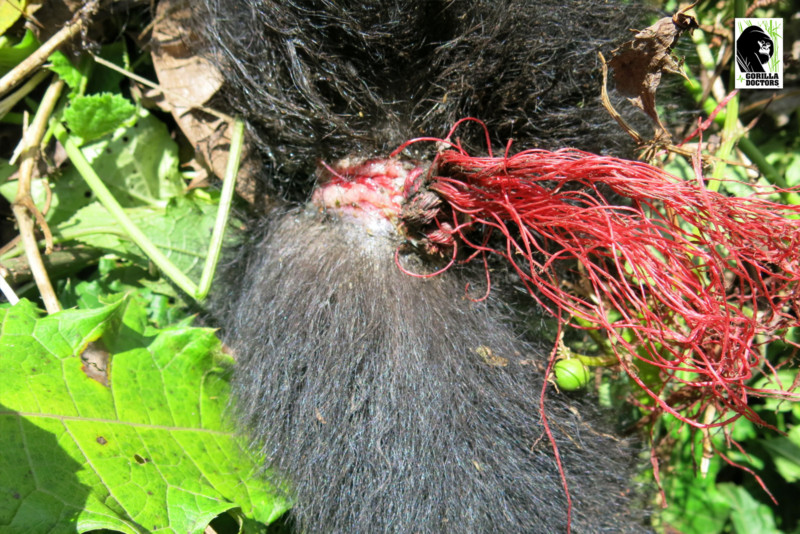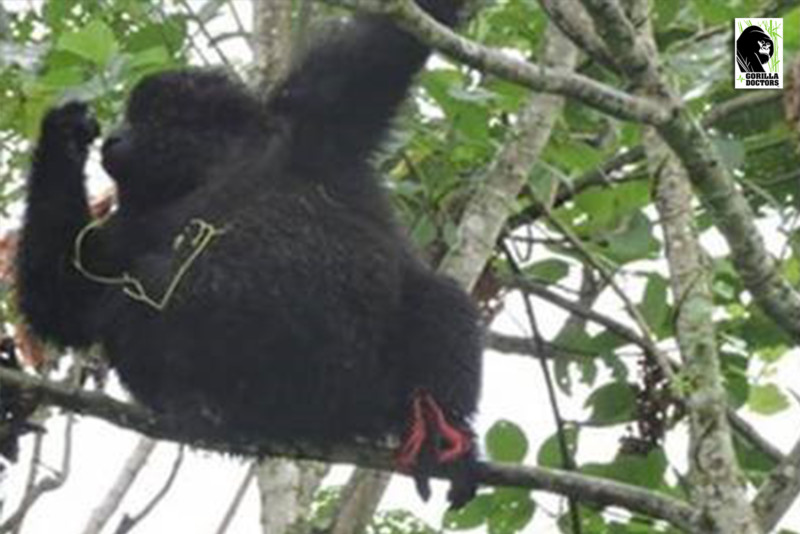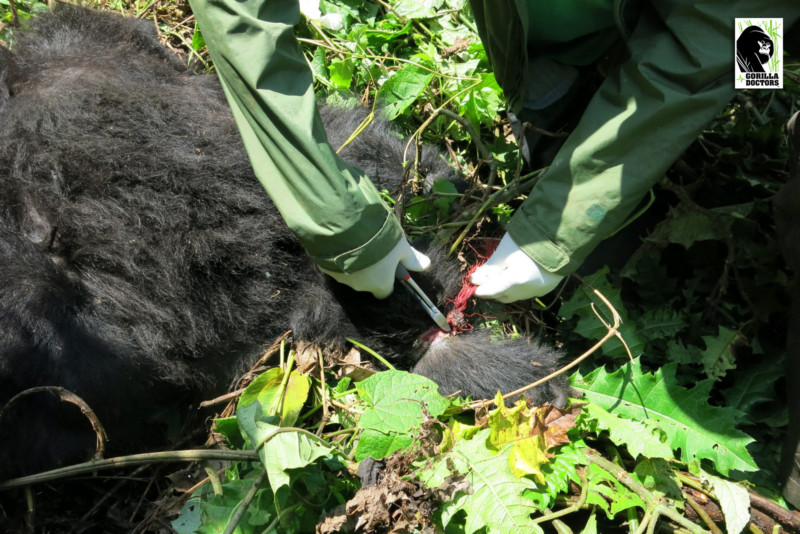A first for Gorilla Doctors: rescue of a semi-habituated mountain gorilla from a snare
By Gorilla Doctors Staff on Tuesday, October 2nd, 2018 in Blog.By Dr. Eddy Kambale
In the middle of September, our Gorilla Doctors team in DR Congo received a report from Virunga National Park rangers that an approximately 6-year-old male mountain gorilla in a group that has been undergoing habituation since March had a snare around its leg.
Habituation is a lengthy process, requiring daily visits by trained park staff to a gorilla group to gradually get the gorillas accustomed to the presence of people, to the point where the group does not fear people and can be visited by tourists and researchers. Gorilla Doctors’ life-saving care for mountain and Grauer’s gorillas is possible because habituated gorillas let us get close enough to see that a gorilla is suffering an illness or injury.
This particular group of about 40 gorillas (including four silverbacks) has been given the temporary name of “Group A”, and its home range is located near the Gikeri ranger patrol post near the active Nyiragongo Volcanoe where there is a tourist camping site for gorilla viewing.
Gorilla Doctors had never before attempted an intervention on a semi-habituated group of mountain gorillas in Virunga National Park.
Our patient was actually observed with this nylon snare around its left ankle months ago, when the habituation process started last March. At that time, the snare appeared loose, and the juvenile was behaving normally: the snare seemed to not be causing any apparent injury to the foot, and this remained the situation for several weeks.
At that time Park authorities shared the news with Gorilla Doctors and after discussion we all agreed to not perform a clinical intervention to remove the loose snare, as the group was in the very early stages of habituation: it was not tolerating human presence, and therefore a veterinary intervention would have been nearly impossible (and dangerous), because it would require people to get much closer to the gorillas. As well, once a gorilla is first darted with an anesthetic, we have to follow it into the forest to monitor the effects of anesthesia in order to avoid anesthetic complications, which can be life-threatening. We worried that with this particular semi-habituated group, once one of their family members was fully anesthetized, they might get extremely anxious, causing a serious setback to the habituation process.
But on September 19th, Park authorities informed us that the health of the juvenile had deteriorated over the previous few days and that the snare was observed getting very tight around the ankle, causing swelling of the foot, and that he was lagging behind the group, resting frequently and not using the foot while walking.
On September 20th, after discussing the various challenges in handling this case, Gorilla Doctors and Park authorities agreed that a monitoring visit was critical, so that we could do a general assessment of the juvenile’s health and the complexity of the situation for a potential intervention. We agreed that Gorilla Doctors would perform a clinical intervention if the opportunity presented itself. This was a difficult decision to make by Park authorities, as they have dealt with gorilla-caused injuries to their staff before during the habituation process.
Nevertheless, we headed into the forest and observed the approximately 35 kg gorilla, and made a plan for the intervention. We agreed that if we were successful in anesthetizing him, we would cut the snare off right away, in case the group got agitated and quickly snatched the gorilla back. We feared this situation because it had happened to us before, with the Lulengo group in 2015. Lulengo group was a habituated group composed of nine gorillas and we needed to remove a snare from a 5-month old baby named Bahoze that was still nursing. We had successfully darted the mother and had just hand-injected the baby with anesthetic, when a young juvenile rushed out and grabbed Bahoze and gave him to the silverback Lulengo, who then ran off into the forest with the anesthetized baby. We followed him but he kept charging us. Eventually, Lulengo dropped Bahoze on the ground andmoved away, allowing us to remove the snare. So that time, we were lucky……But we worried that a similar situation could occur with Group A.
Unfortunately, we missed the first dart attempt, and the juvenile was staying very close to the dominant silverback, which fortunately stayed calm and tolerated our presence at such close proximity. Other gorillas in the group simply sat around watching us. The group behaved as a fully habituated group would, and this attitude gave us some hope that we would succeed with the intervention. We decided to postpone another darting attemtpt to the next day, and left the group still calm.
On Friday September 21st, we started our forest walk very early in the morning, and located the group feeding. After about 45 minutes, they started their morning rest period, but we had not yet seen the snared juvenile. We kept looking for him and finally found hime about an hour later, feeding occasionally and sitting between the silverback and an adult female. We watched them for a short time and decided to make another attempt to dart him. Fortunately this time we were successful; the juvenile did not cry out when darted and he moved away from the two gorillas. The silverback picked up the dropped dart, sniffed it, dropped it on ground, and then moved away, leaving the juvenile behind while he started showing some anesthesia effect. The rest of the group members continued to feed quietly at short distance under thick vegetation, unaware of what was happening around them, and we easily proceeded with the snare removal intervention.
Under anesthesia, we observed that the juvenile’s leg was swollen above and below the tight nylon red rope around his ankle, which was cutting through the skin and the muscle leaving an opened wound. On one side of the ankle, the skin had actually healed over the nylon rope. The wound was already infected and the mobility of the joint of the foot was fairly reduced, but it appeared there were no bony fractures. We removed the snare, cleaned the wound, administered pain relievers and antibiotics, and reversed the anesthesia. Once he was waking up, the juvenile was back with his group within minutes of our intervention.
We have since observed the juvenile feeding and walking well, suggesting that he will make a full recovery from his snare wound. Gorilla Doctors and our colleagues at Virunga National Park have shared a collective sigh of relief that this first intervention on a semi-habituated group of mountain gorillas went so smoothly.


 Donate
Donate



